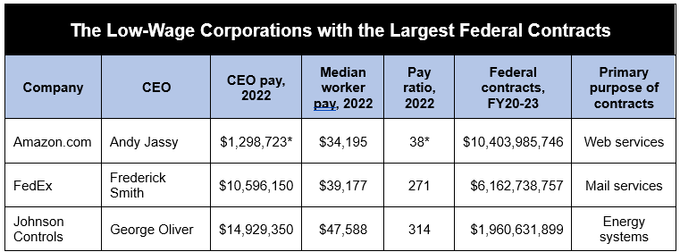Why should taxpayers subsidize stock buy-backs?
SARAH ANDERSON, Inequality.Org
The reasoning? These CHIPS program subsidies, explained Commerce
Secretary Gina Raimondo, “should be used to expand in America, to out-innovate
the rest of the world. Invest in R&D and your workforce, not in buybacks.”
Wielding the power of the public purse against buybacks
makes total sense.
Taxpayers want every dollar of their public investments
to produce maximum benefits. But every dollar spent on stock buybacks is a
dollar not spent on worker wages, R&D, and other productive investments to
stimulate long-term growth and make U.S. companies more competitive. Analysts
have documented how buybacks are associated with reduced capital investment and
innovation and wage stagnation.
And yet in the past two years, S&P 500 corporations
spent record annual sums repurchasing
their own stock—$922.7 billion in 2022 and $881.7 billion in 2021. In the first
half of 2023, share repurchases were down a bit but still an eye-popping $390.5 billion.
What’s the goal of all these buybacks? This financial
maneuver artificially inflates the value of a company’s share price by reducing
the supply on the open market. That keeps shareholders happy. It also
creates huge windfalls for CEOs,
since most of their compensation is in some form of stock-based pay, and their
bonuses are often tied to financial targets that can be influenced by stock
buybacks.
Using public funds as a lever for discouraging this practice is good policy. But why just go after semiconductor companies? Why not all corporations receiving federal funds of any sort?
Chip makers are notorious for their profligate buyback spending.
But so are many other companies that are feeding at the federal trough—or stand
to do so through new legislation.
Stock Buybacks by Low-Wage Federal Contractors
 |
| Source: Institute for Policy Studies, Executive Excess 2023. *Jassy accepted modest pay in 2022 after receiving a 2021 stock grant valued at $212 million. |
A recent Institute for Policy Studies report takes a deep dive into the 100 S&P 500 corporations with the lowest median worker wages, a group we’ve dubbed the “Low-Wage 100.”
We found that 51 of these firms are federal contractors, with a combined $24.1 billion in deals during fiscal years 2020-2023. Meanwhile, these 51 low-wage contractors spent nearly $160 billion on stock buybacks.
The largest? Amazon, with at least $10.4 billion in contracts for web services. Since January 2020, the e-commerce goliath has spent $6 billion on buybacks while paying their median worker just $34,195.
These share repurchases have helped pump up Amazon CEO Andy Jassy’s personal
holdings of Amazon stock to $265 million. These millions do not include
the bulk of his 2021 mega-grant, a reward that will vest over 10 years.
FedEx, the second-largest contractor in the Low-Wage 100,
pocketed $6.2 billion from Uncle Sam in fiscal years 2020-2023. FedEx spent
$3.6 billion on buybacks during this period, a maneuver that helped prop up the
value of CEO Fred Smith’s more than $5 billion in personal stock holdings, the
largest stash held by any CEO in the Low-Wage 100.
In 2022, his last year before transitioning to the FedEx
executive chair slot, Smith made $10.6 million, 271 times FedEx median worker
pay. Unlike competitor UPS, where more than 70% of employees
are unionized, FedEx is notoriously anti-union.
Number three on our low-wage contractor list is Johnson Controls. Originally based in Milwaukee, the company moved its headquarters to Ireland in 2016 to lower its U.S. tax bill.
But the company continues to receive major taxpayer-funded federal contracts, a
haul worth nearly $2 billion in FY2020-2023, primarily for upgrading federal
buildings to a more energy-efficient status.
The firm could receive considerably more federal support
over coming years, thanks to new infrastructure and energy legislation. Under
CEO George Oliver’s leadership, the firm has spent $4.5 billion on stock
buybacks since 2020. That contributed to a 139% increase in his personal
stockholdings, to $131.7 million. In 2022 Oliver made 314 times as much as his
typical employee.
Wielding the Power of the Public Purse to Narrow Pay
Disparities
Extending the CHIPS program conditions on stock buybacks
to all firms receiving federal contracts, subsidies, and grants should be a
no-brainer. It would complement President Joe Biden’s support for other tools
for reducing buybacks, including his proposal to quadruple a new 1% excise tax on
share repurchases.
The administration could also do much more to leverage the power of the public purse against extreme pay disparities. The proposed Patriotic Corporations Act could serve as a model.
This bill would grant preferential treatment in contracting
to firms with CEO-worker pay ratios of 100 to 1 or less, among other
benchmarks, including neutrality in union organizing. The Congressional Progressive Caucus has
called on Biden to introduce such incentives.
By encouraging big companies to narrow their pay gaps,
the administration would also help ensure that taxpayers get the biggest bang
for the buck for federal contract dollars. Studies have shown that
companies with narrow gaps tend to perform better because more equitable pay
practices tend to bring out the best in all employees.
The administration should also build on Biden’s executive
order requiring large construction firms involved in public infrastructure
projects to negotiate collective agreements with
their workers. Unions and other pro-worker advocacy groups have called on the
president to expand that requirement to
contractors that provide goods and other services.
In fiscal 2022, Uncle Sam awarded more than $705
billion in unclassified contracts (and an undisclosed amount of
classified contracts). Billions more go out the door every year in the form of
subsidies, grants, and tax credits.
We should view these public funds as a source of power to create an economy that works for everyone. Public money should support the public goodnot line the pockets of overpaid CEOs.
SARAH ANDERSON
directs the Global Economy Project of the Institute for Policy Studies, and is
a co-editor of Inequality.org.
:max_bytes(150000):strip_icc():format(webp)/buyback.asp-Final-5a1ff1b0e4294d8293b5b3a044417e70.jpg)